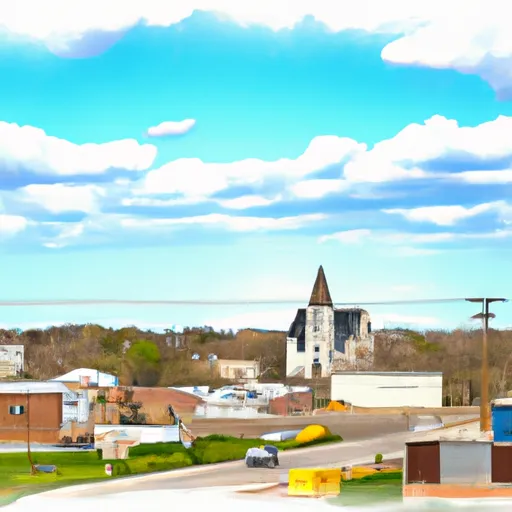-
 Snoflo Premium
Snoflo Premium
Get unlimited access to all our content
With no Ad interruptions! - Start Your Free Trial Login with existing account
Holyrood
Eden Index
Climate
9.8
•
Recreation
•
Community
0.7
•
Safeguard
4.1/10

Holyrood is a small town located in central Kansas, known for its diverse climate and the various outdoor recreational opportunities it offers. The climate in Holyrood is characterized by hot summers and cold winters, with an average temperature of 55°F. The area experiences moderate precipitation throughout the year, with slightly higher rainfall during the summer months.
Holyrood is situated near the Smoky Hill River, which plays a significant role in the town's hydrology constituents. The river provides a source of water for irrigation and supports a variety of wildlife and vegetation. Additionally, the region features several small lakes and ponds that offer fishing and boating opportunities.
Outdoor enthusiasts in Holyrood can enjoy a range of recreational activities. The picturesque landscape surrounding the town provides opportunities for hiking, camping, and wildlife observation. The nearby Wilson Lake offers fishing, swimming, boating, and water skiing. Additionally, there are several parks and trails in and around Holyrood that cater to individuals seeking leisurely walks or picnicking spots.
In conclusion, Holyrood, Kansas offers a diverse climate, with moderate precipitation and distinct seasons. Its hydrology constituents are shaped by the Smoky Hill River, providing water resources for irrigation and supporting various flora and fauna. Outdoor recreation opportunities in the area include hiking, camping, fishing, boating, and wildlife observation, making Holyrood a great destination for nature lovers and outdoor enthusiasts.
What is the Eden Index?
The Snoflo Eden Index serves as a comprehensive rating system for regions, evaluating their desirability through a holistic assessment of climate health, outdoor recreation opportunities, and natural disaster risk, acknowledging the profound impact of these factors on livability and well-being.
Climate Health Indicator (CHI): 9.8
Holyrood receives approximately
683mm of rain per year,
with humidity levels near 74%
and air temperatures averaging around
13°C.
Holyrood has a plant hardyness factor of
6, meaning
plants and agriculture in this region thrive during a short period during spring and early summer. Most
plants will die off during the colder winter months.
By considering the ideal temperature range, reliable water supplies, clean air, and stable seasonal rain or snowpacks, the Climate Health Indicator (CHI) underscores the significance of a healthy climate as the foundation for quality living.
A healthy climate is paramount for ensuring a high quality of life and livability in a region, fostering both physical well-being and environmental harmony. This can be characterized by ideal temperatures, reliable access to water supplies, clean air, and consistent seasonal rain or snowpacks.
Weather Forecast
Streamflow Conditions
Middle Arkansas
Area Rivers
Middle Arkansas
Snowpack Depths
Middle Arkansas
Reservoir Storage Capacity
Middle Arkansas
Groundwater Levels
Recreational Opportunity Index (ROI):
The Recreational Opportunity Index (ROI) recognizes the value of outdoor recreational options, such as parks, hiking trails, camping sites, and fishing spots, while acknowledging that climate plays a pivotal role in ensuring the comfort and consistency of these experiences.
Access to outdoor recreational opportunities, encompassing activities such as parks, hiking, camping, and fishing, is crucial for overall well-being, and the climate plays a pivotal role in enabling and enhancing these experiences, ensuring that individuals can engage in nature-based activities comfortably and consistently.
Camping Areas
| Campground | Campsites | Reservations | Toilets | Showers | Elevation |
|---|---|---|---|---|---|
| Minooka - Wilson Reservoir | 220 | 1,577 ft | |||
| Wolf Pond Park | None | 1,802 ft | |||
| Medicine Lodge City Park | 5 | 1,466 ft | |||
| Jewell State Fishing Lake | None | 1,684 ft | |||
| Glen Elder State Park | 425 | 1,470 ft | |||
| Lucas - Wilson Reservoir | 100 | 1,594 ft | |||
| Sylvan - Wilson Reservoir | 30 | 1,491 ft | |||
| Ellinwood City Park | 5 | 1,796 ft |
Nearby Fishing
Nearby Ski Areas
Catastrophe Safeguard Index (CSI):
The Catastrophe Safeguard Index (CSI) recognizes that natural disaster risk, encompassing floods, fires, hurricanes, and tornadoes, can drastically affect safety and the overall appeal of an area.
The level of natural disaster risk in a region significantly affects safety and the overall livability, with climate change amplifying these risks by potentially increasing the frequency and intensity of events like floods, fires, hurricanes, and tornadoes, thereby posing substantial challenges to community resilience and well-being.
Community Resilience Indicator (CRI): 0.7
The Community Resilience Indicator (CRI) recognizes that education, healthcare, and socioeconomics are crucial to the well-being of a region. The CRI acknowledges the profound impact of these elements on residents' overall quality of life. By evaluating educational resources, healthcare accessibility, and economic inclusivity, the index captures the essential aspects that contribute to a thriving community, fostering resident satisfaction, equity, and social cohesion.

